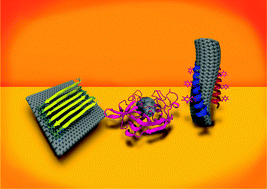Interfacing proteins with graphitic nanomaterials: from spontaneous attraction to tailored assemblies
Abstract
This critical review aims at giving insights on the spontaneous tendency of proteins and their constitutive parts to adsorb on graphitic nanomaterials (GNMs) through non-covalent interactions occurring at their interfaces. Specifically, it focuses on the theoretical and experimental studies carried out to comprehend in depth the forces ruling the adsorption processes of proteins on fullerene, carbon nanotubes and graphene. In a systematic way the reader is guided through the most recent and representative examples describing at the atomistic level of detail the structural modalities and the chemico-physical principles through which amino acids, polypeptides and folded proteins interact with GNMs' surface, thereby taking into consideration the mutual effects of both protein structural complexity and nanomaterial topology. Based on their chemical and structural features, the study and understanding of the protein–nanomaterial interfaces can be exploited in the view of design and control the spontaneous formation of biologically-active hybrid materials for the development of new tailored applications in the field of sensing, nanomedicine and biochemistry.


 Please wait while we load your content...
Please wait while we load your content...